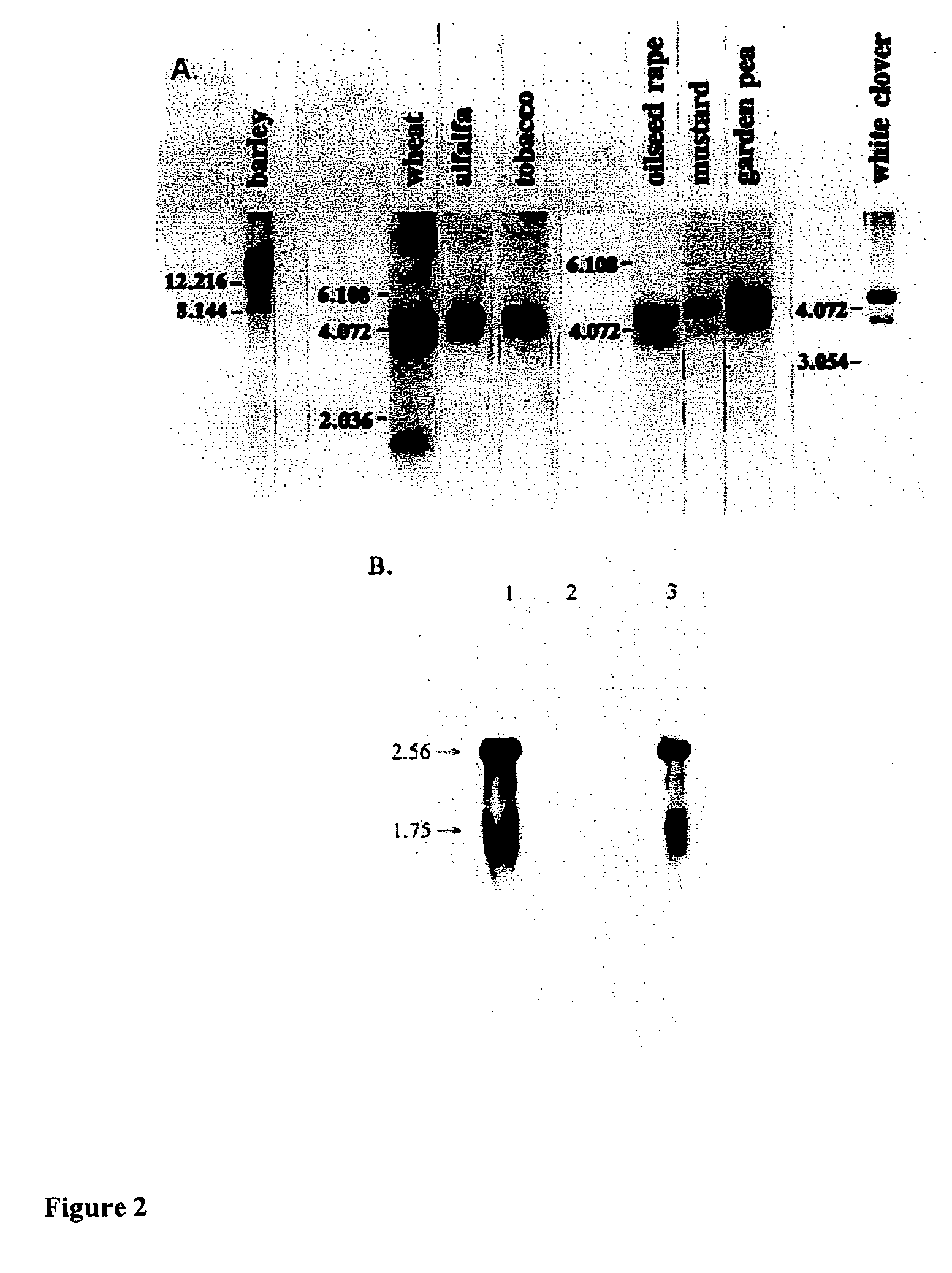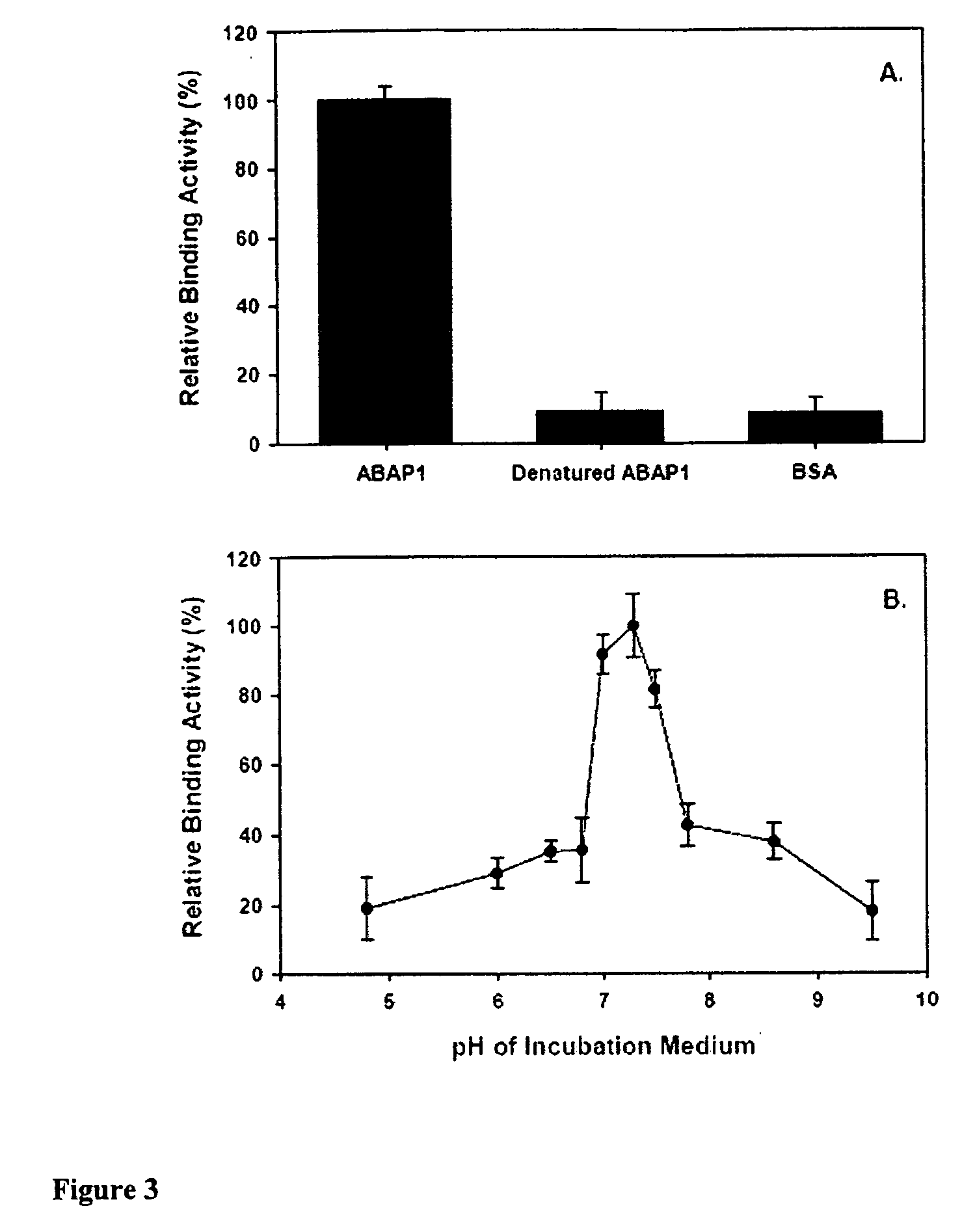Plant proteins having an abscisic acid binding site and methods of use
a plant protein and binding site technology, applied in the field of plant proteins involved in signal transduction, can solve the problems of low oil quality, difficult to relate these proteins to any physiological role of aba, and no success in characterizing putative aba receptors
- Summary
- Abstract
- Description
- Claims
- Application Information
AI Technical Summary
Benefits of technology
Problems solved by technology
Method used
Image
Examples
example 1
Expression and Purification of FCA Proteins
[0112] For ABA binding assays, FCA recombinant protein (the 3′ end of FCAγ possessing the WW domain) expressed in E. coli as a fusion proteinS with GST was purified. Seventy mL of LB culture media was infected by an overnight 10 mL culture of recombinant FCA- WW clone (plus 100 mg L−1 ampicillin) and incubated for 30 minutes at 37° C. until OD600 reached 0.5. The expression of FCA was induced by the addition of 1 mM IPTG and the culture was allowed to grow for 4 hours at 37° C. Following induction, the culture was centrifuged to pellet the cells and resuspended in 5 mL g−1 PBST lysis buffer, pH 7.0 (10 mM Na2H2PO4, 1.8 mM KH2PO4 140 mM NaCl, 2.7 mM KCl, and 1% Triton X-100), left on ice for 15 minutes, freeze / thawed before sonication (6×10 seconds at 200-300 W with 10 second rests). Following centrifugation at 12,000 g at 4° C. for 20 minutes, the supernatant was mixed with 1 mL of pre-equilibrated (PBST) GST Affinity Resin (Stratagene) by...
example 2
ABA Binding Assays
[0114] Crude lysate and purified FCA protein were used to determine the ABA binding activity as describedV. Briefly, the incubation medium consisted of 12.5 mM Tris-HCl, pH 7.3 containing 50 nM 3H+-ABA (except when the kinetics of FCA was determined), and 10 μg purified FCA protein or the equivalent of 50 μg crude lysate. All binding assays were carried out at a final volume of 200 μL at 4° C. for 45 minutes. The mixture was then rapidly filtered through a nitrocellulose membrane, washed with 0.5× binding buffer, air dried and counted in a scintillation counter (Wallac 1414 WinSpectral v1.40). Heat denatured FCA protein was used to determine the protein nature of the FCA and BSA was used as a control. All binding studies were carried out using three different GST affinity chromatography protein purifications with triplicate assays for each purification. For the competitive asays, ABA analogs (−)-ABA and trans-ABA were added at the same time as 3H+-ABA at different...
example 3
GST Binding Assays of FCA-FY Interaction
[0115] All in vitro translation and GST pull-down assays were carried out as described by supplier's protocols (Promega, Madison, Wisc.) with modificationsS and as follows. For GST in vitro pull-down assays, 15 μL GST affinity resin was incubated with 250 μL FCA clear lysate, pelleted and the complex blocked and washed with IP buffer as describedS. For the determination of the amount of FCA bound to GST resin, the pellet was resuspended with 200 μL of 15 mM GSH to elute FCA and the supernatant was recovered by centrifugation. FY protein to be tested for interaction with the GST-FCA fusion protein was synthesized from a plasmid template and labeled with [35S]-methionine using the T7 TNT coupled Transcription / Translation System (Promega). Twenty μL of FY labeled protein and 180 μL of interaction buffer (12.5 mM Tris-HCl, pH 7.3 containing 5 mM KCl, 1 mM MgCl2, and 100 mM NaCl) were used to resuspend the GST:FCA after the final wash. The protein...
PUM
| Property | Measurement | Unit |
|---|---|---|
| Molar density | aaaaa | aaaaa |
| Atomic weight | aaaaa | aaaaa |
| Atomic weight | aaaaa | aaaaa |
Abstract
Description
Claims
Application Information
 Login to View More
Login to View More - R&D
- Intellectual Property
- Life Sciences
- Materials
- Tech Scout
- Unparalleled Data Quality
- Higher Quality Content
- 60% Fewer Hallucinations
Browse by: Latest US Patents, China's latest patents, Technical Efficacy Thesaurus, Application Domain, Technology Topic, Popular Technical Reports.
© 2025 PatSnap. All rights reserved.Legal|Privacy policy|Modern Slavery Act Transparency Statement|Sitemap|About US| Contact US: help@patsnap.com



